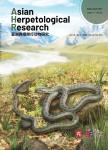Pathological Changes in Andrias davidianus Infected with Chinese Giant Salamander Ranavirus
Pathological Changes in Andrias davidianus Infected with Chinese Giant Salamander Ranavirus作者机构:College of Veterinary MedicineSichuan Agricultural University Center for Wildlife HealthUniversity of Tennessee Department of AquacultureSichuan Agricultural University
出 版 物:《Asian Herpetological Research》 (亚洲两栖爬行动物研究(英文版))
年 卷 期:2016年第7卷第4期
页 面:258-264页
核心收录:
学科分类:0710[理学-生物学] 0905[农学-畜牧学] 09[农学] 0906[农学-兽医学]
基 金:supported by the Sichuan Technology Support Planning (No.2014NZ0027) Sichuan Academic Leader Training Fund (No.2015RST0016)
主 题:pathology CGSRV Andrias davidianus ranavirus China
摘 要:Chinese giant salamander ranavirus (CGSRV) is an emerging pathogen in captive populations of the Chinese giant salamander (Andrias davidianus). We processed 140 morbid Chinese giant salamanders from seven captive breeding populations over five years, and describe the disease associated with CGSRV infection. The most common gross signs were significant swelling of the legs and coelomic cavity, erythema of the legs and ventrum in juveniles; cutaneous erosions and ulcerations in adults, particularly the limbs and the head; and marked petechial or ecchymotic hemorrhages of the internal organs, particularly the liver, spleen and kidney. Histological examination showed degeneration, necrosis, and inflammation in many organs, particularly in the organs where hemorrhage was observed. There was evidence of eosinophilic inclusion bodies in degenerated and necrotic cells. We identified virus particles and empty capsids without viral nucleoid in the inclusion bodies using electron microscopy. Virus particles were hexagonal or round shape, and appeared in paracrystalline arrays, aggregates, or singly. All enveloped viral particles were 140-160 nm. Polymerase chain reaction followed by sequencing verified that the virus particles were CGSRV. These results collectively support that CGSRV was the etiologic agent responsible for these mass die-offs of the Chinese giant salamander. The pathology described herein will be useful in diagnosing cases of ranaviral disease caused by CGSRV, and provide evidence that this pathogen is a significant threat to the Chinese giant salamander.



